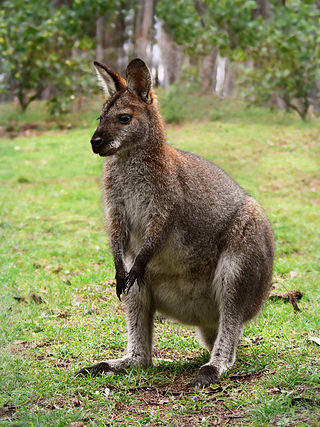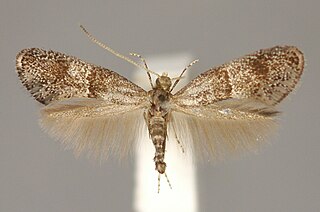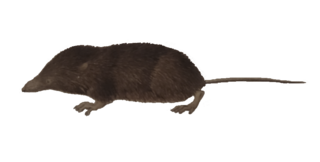
Columbidae is a bird family consisting of doves and pigeons. It is the only family in the order Columbiformes. These are stout-bodied birds with short necks and short slender bills that in some species feature fleshy ceres. They primarily feed on seeds, fruits, and plants. The family occurs worldwide, but the greatest variety is in the Indomalayan and Australasian realms.

A wallaby is a small or middle-sized macropod native to Australia and New Guinea, with introduced populations in New Zealand, Hawaii, the United Kingdom and other countries. They belong to the same taxonomic family as kangaroos and sometimes the same genus, but kangaroos are specifically categorised into the four largest species of the family. The term "wallaby" is an informal designation generally used for any macropod that is smaller than a kangaroo or a wallaroo that has not been designated otherwise.

The Anatidae are the biological family of water birds that includes ducks, geese, and swans. The family has a cosmopolitan distribution, occurring on all the world's continents except Antarctica. These birds are adapted for swimming, floating on the water surface, and in some cases diving in at least shallow water. The family contains around 174 species in 43 genera.

The rails, or Rallidae, are a large cosmopolitan family of small- to medium-sized, ground-living birds. The family exhibits considerable diversity and includes the crakes, coots, and gallinules. Many species are associated with wetlands, although the family is found in every terrestrial habitat except dry deserts, polar regions, and alpine areas above the snow line. Members of the Rallidae occur on every continent except Antarctica. Numerous island species are known. The most common rail habitats are marshland and dense forest. They are especially fond of dense vegetation.

Starlings are small to medium-sized passerine birds in the family Sturnidae. The Sturnidae are named for the genus Sturnus, which in turn comes from the Latin word for starling, sturnus. Many Asian species, particularly the larger ones, are called mynas, and many African species are known as glossy starlings because of their iridescent plumage. Starlings are native to Europe, Asia, and Africa, as well as northern Australia and the islands of the tropical Pacific. Several European and Asian species have been introduced to these areas, as well as North America, Hawaii, and New Zealand, where they generally compete for habitats with native birds and are considered to be invasive species. The starling species familiar to most people in Europe and North America is the common starling, and throughout much of Asia and the Pacific, the common myna is indeed common.
Located about 2300 miles (3680 km) from the nearest continental shore, the Hawaiian Islands are the most isolated group of islands on the planet. The plant and animal life of the Hawaiian archipelago is the result of early, very infrequent colonizations of arriving species and the slow evolution of those species—in isolation from the rest of the world's flora and fauna—over a period of at least 5 million years. As a consequence, Hawai'i is home to a large number of endemic species. The radiation of species described by Charles Darwin in the Galapagos Islands which was critical to the formulation of his theory of evolution is far exceeded in the more isolated Hawaiian Islands.

Suina is a suborder of omnivorous, non-ruminant artiodactyl mammals that includes the domestic pig and peccaries. A member of this clade is known as a suine. Suina includes the family Suidae, termed suids, known in English as pigs or swine, as well as the family Tayassuidae, termed tayassuids or peccaries. Suines are largely native to Africa, South America, and Southeast Asia, with the exception of the wild boar, which is additionally native to Europe and Asia and introduced to North America and Australasia, including widespread use in farming of the domestic pig subspecies. Suines range in size from the 55 cm (22 in) long pygmy hog to the 210 cm (83 in) long giant forest hog, and are primarily found in forest, shrubland, and grassland biomes, though some can be found in deserts, wetlands, or coastal regions. Most species do not have population estimates, though approximately two billion domestic pigs are used in farming, while several species are considered endangered or critically endangered with populations as low as 100. One species, Heude's pig, is considered by the International Union for Conservation of Nature to have gone extinct in the 20th century.

Galemys is a genus of mole containing the living Pyrenean desman (Galemys pyrenaicus) and several fossil species.

Geochelone is a genus of tortoises.

Bettongs, species of the genus Bettongia, are potoroine marsupials once common in Australia. They are important ecosystem engineers displaced during the colonisation of the continent, and are vulnerable to threatening factors such as altered fire regimes, land clearing, pastoralism and introduced predatory species such as the fox and cat.

Cylindraspis is a genus of recently extinct giant tortoises. All of its species lived in the Mascarene Islands in the Indian Ocean and all are now extinct due to hunting and introduction of non-native predators.
Perdicella fulgurans is an extinct species of tropical tree-living, air-breathing, land snail, arboreal pulmonate gastropod mollusks in the family Achatinellidae.
†Perdicella maniensis was a species of tropical air-breathing land snail, a terrestrial pulmonate gastropod mollusk in the family Achatinellidae. This species was endemic to Hawaii in the United States.
†Perdicella zebra was a species of tropical tree-living, air-breathing, land snail, an arboreal pulmonate gastropod mollusk in the family Achatinellidae. This species was endemic to Hawaii in the United States.

Achatinellidae is a family of tropical air-breathing land snails, terrestrial pulmonate gastropod mollusks in the superfamily Pupilloidea.

Tinagma perdicella is a moth in the family Douglasiidae. It is found in the Netherlands, Belgium, France, Germany, Switzerland, Austria, Italy, Spain, Poland, Albania, Serbia, Croatia, the Czech Republic, Slovakia, North Macedonia, Romania, Norway, Sweden, Finland, the Baltic region, Belarus, Ukraine and Russia.

Soriculus is a genus of shrew native to Asia. Along with several fossil species, the only extant member of the genus is the Himalayan shrew, as other extant species have now been transferred to other genera.













